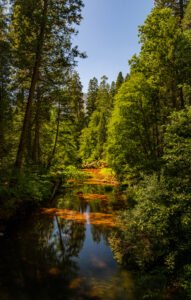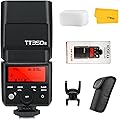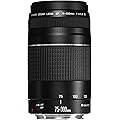Everything You Need To Know About Landscape Photography
Don Orkoskey | April 30, 2023

Are you curious about landscape photography? Here is everything you need to know about landscape photography to get started in this wonderful subject.
What is Landscape Photography?
Landscape photography is the creation of photos featuring views of natural or manmade creations. These features are photographed at a scale larger than what one can consider a close-up.
While sweeping grand vistas are often what we think of as landscape photographs. Your landscape photos don't need to be limited to just these types of pictures. After all, it can be difficult to find these types of images if you live in an environment that doesn't contain them.
Types of Landscape Photos
There are many types of landscape photos. We can begin to categorize them by dividing them first between these grand vistas and smaller vignettes or more intimate studies. You can make these smaller landscape vignettes in the forest, or other more confined spaces. We can capture incredible photos near cities and towns or other crowded places.
Landscape Subjects
We can further break down landscapes by their subject matter. The following are often seen landscape subjects.
- Seascapes
- Cityscapes
- Natural Landscapes
- Single Buildings in beautiful settings
- Sunset studies
Lets break each of these down.
Seascapes
Seascapes are fairly self-explanatory, they are photos of the sea. Often these include cliffs, dunes, or other natural features. They might also include buildings such as lighthouses or structures such as boardwalks and amusement parks.
Cityscapes
Cityscapes are also easy to identify. These are photos that feature cities (or even smaller towns) as the subject. This is different than street photography even if there are people in the photos because the subject is the built environment and not the people. People are often there just for scale.
Natural Landscapes
Natural Landscapes often feature mountains, waterfalls, large open fields, individual or small groups of trees, forested lands, cliffs or similar subjects.
Single Buildings In Beautiful Settings
Many might not make a distinction between natural landscapes and those featuring a single building in a beautiful setting but I find them to be different. These are often churches, cabins, or other man-made structures that create a sense of scale and/or give us as viewers a place to focus and center ourselves in the image.
Sunset studies
Like others in this list sunset studies are easy to identify. However, that doesn't mean they are easy to create. You really need to understand how to manage exposure to capture all of the colors. Additionally, you might need to bracket in order to have all the details you want in the photo. Finally, they're not easy because they're so ubiquitous. Everyone with a phone captures photos of beautiful sunsets (even if they don't come out well). Creating one that stands out is therefore a challenge.
Advertisements
What Every Landscape Photo Needs
 Every landscape photo needs to have a subject. That means a focal point. Without an easy to define subject the viewer doesn't know where to look. That subject doesn't need to be a concrete object, but just the place the viewer's eye will nearly always come to rest.
Every landscape photo needs to have a subject. That means a focal point. Without an easy to define subject the viewer doesn't know where to look. That subject doesn't need to be a concrete object, but just the place the viewer's eye will nearly always come to rest.
Confused yet? Let's clear that up.
The subject in a landscape photo can be explicit. It can be a mountain top, a single tree, or the sun. That said, it doesn't need to be. It only needs to be the point at which the viewer's eye will center on. In the photo of the Merced River to the left, that point is the turn in the river where a bright, warm colored downed tree is sitting.
Using Implied Subject
In this photo I am using an implied subject. It's not explicit, it's not a concrete object (though the downed tree clearly is a concrete object). The viewer isn't looking at the downed tree, they're looking at the area where the tree is. This is because of the lines of perspective that are created by the riverbank, trees, and the opening of the sky. Additionally the tree's shade and reflection of the sky in the river moves our eyes in that direction.
Implied subjects are not superior to concrete easy to identify subjects. However, they are a tool you can use if you don't have an explicit subject. To use implied subjects in landscape photography, spend time looking at your scene and notice where your eye is drawn to and where it rests. Then make sure the rest of the photo leads the viewer to that same place.
Design Tools for The Best Landscape Photography
Here are some great design tools you can use to improve your landscape photos. We've already talked about the need for a subject and focusing the viewers attention there. To do this we can use a few different design tools.
Color In Landscape Photography
Color is important in all photography and in landscape photography we can use it to guide our viewer through the photo. One of the easiest ways to do this is by understanding warm and cool colors.
Warm colors (red, orange, yellow) seem to come towards the viewer whereas cool colors (green, blue, purple) seem to recede away from us.
Additionally, warm colors attract more attention. This means we can count on the viewer looking at warm colored areas of the photo first. We can use this in post production by accentuating the warmth and coolness of areas to guide the viewer.
Lines and Shapes
Lines and shapes also help tell our viewers things about the photo. Lines in particular can point the viewer where we want them to go. If not done correctly they can point them in the wrong direction. Shapes have cultural significance. Triangles, for example, are a symbol of strength.
Landscape Scale
Helping the viewer understand the scale of the landscape they are looking at can make it more impressive. This is one reason you'll often see people or buildings in an otherwise wild landscape. Both can offer a sense of scale.
Now You Know Everything About Landscape Photography
It might not feel like it but you now know everything about landscape photography to get you started or to take your landscape photos to the next level. Sure there are loads of other things to learn but they're best learned by practice. Knowing what lens to use takes being there for example. Wide angle lenses capture more but they also distort things. As a result a lens that is too wide will make everything look tiny.
Keep Learning About Landscape Photography
While this is everything you need to know to get out there and create you absolutely should keep learning about landscape photography. You can find great landscape photographers to follow online such as Mads Peter Iverson. I also encourage you to sign up for my newsletter which is full of great photography information. If you have any questions please contact us at Learn To Take Photos.
Godox Flash Godox iM30 Mini Flash - Camera Flash GN 15, 7 Power Levels, IM 30 Mini Manual Flash for Canon/Sony zv1/Sony zve10 /Ricoh gr3/Fuji f1-230 Full-Power Flashes/6500K±200K/3.6S Recycle
$34.90 (as of December 26, 2025 19:15 GMT -05:00 - More infoProduct prices and availability are accurate as of the date/time indicated and are subject to change. Any price and availability information displayed on [relevant Amazon Site(s), as applicable] at the time of purchase will apply to the purchase of this product.)Sigma 16mm f/1.4 DC DN Contemporary Lens for Sony E (402965)
$443.74 (as of December 26, 2025 19:15 GMT -05:00 - More infoProduct prices and availability are accurate as of the date/time indicated and are subject to change. Any price and availability information displayed on [relevant Amazon Site(s), as applicable] at the time of purchase will apply to the purchase of this product.)JOILCAN Phone Tripod Stand, 68" Tripod for iPad iPhone Tablet with Remote Universal Holder Carry Bag, Travel Aluminum Tripod for Video Recording Photos Vlogging Compatible with iPad Pro iPhone Camera
$26.99 (as of December 26, 2025 19:15 GMT -05:00 - More infoProduct prices and availability are accurate as of the date/time indicated and are subject to change. Any price and availability information displayed on [relevant Amazon Site(s), as applicable] at the time of purchase will apply to the purchase of this product.)Godox TT350S Flash for Sony Camera, 2.4G GN36 TTL Mini Camera Flash Speedlite HSS 1/8000s, Approx.210 Full Power Flashes, External Flash for Sony a7RII a7R a350 a6000 a9 a9III a6400 a6500 etc
$76.00 (as of December 26, 2025 19:15 GMT -05:00 - More infoProduct prices and availability are accurate as of the date/time indicated and are subject to change. Any price and availability information displayed on [relevant Amazon Site(s), as applicable] at the time of purchase will apply to the purchase of this product.)Canon EF 75-300mm f/4-5.6 III Telephoto Zoom Lens for Canon SLR Cameras
Now retrieving the price.
(as of December 26, 2025 19:15 GMT -05:00 - More infoProduct prices and availability are accurate as of the date/time indicated and are subject to change. Any price and availability information displayed on [relevant Amazon Site(s), as applicable] at the time of purchase will apply to the purchase of this product.)




